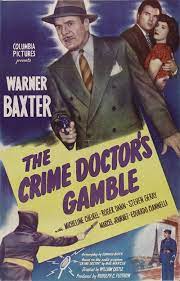
Dr. Robert Ordway (Warner Baxter) is in Paris, France giving a few lectures on modern psychiatry as a crime fighting tool. While he is there, he is visiting his friend, Inspector Jacques Morrell (Marcel Journet). Morrell wines and dines him. After a long night of merriment Ordway goes to the Prefecture de Police the next day to have lunch with Morrell. While he is there Morrell asks Ordway to talk to a man who was arrested for murdering his father.
Henri Jardin (Roger Dann) had married Mignon Duval (Micheline Cheirel), a woman that Henri’s wealthy father disapproved of. Henri and his father had an argument and his father threatened to cut him off without a penny. Henri remembers being angry with his father but doesn’t remember killing him. Morrell knows Henri from when they were in a concentration camp together. Henri has a form of PTSD and has had issues of not remembering events before. His time in the camp sent Henri to an institution for a while. Morrell now asks Ordway to determine if Henri is insane or not.
It seems there is more to the mystery when Henri’s painter friend, Anton Geroux (Maurice Marsac) is murdered during a robbery. The only things missing are copies of famous paintings that Geroux was commissioned to paint. This leads Ordway down a path involving forgery as well as more murders, and Ordway is running out of suspects.
“The Crime Doctor’s Gamble” was released in 1947 and was directed by William Castle. It is an American crime mystery and the last of four Crime Doctor films that Castle directed. It is also the ninth of ten crime doctor films done by Columbia Pictures.
Similar to the rest of the crime doctor cannon, it is a decent mystery film that includes a plot that meanders from a father-son argument to something deeper and more complex. It is a fun and entertaining little mystery.
Purportedly, Ordway is in France visiting a cabaret. To make it appear authentic the audience is treated to Apache dancing, also called La Danse Apache. Reportedly, Apache dancing was created by Maurice Mouvet and Max Dearly in 1908 and was named after Parisian street gangs that roamed Paris. Although pronounced differently, the gangs were named by the French press who described their violence toward each other as reminiscent of American Indigenous people. The actual pronunciation is (ah-PAHSH).
The dance style includes mock slaps, punches and images of women being pulled around by their hair. It also includes the woman being thrown to the ground and other exaggerated abusive treatment, and all done to music. The dance is sometimes said to represent an interaction between a pimp and his prostitute or a gangster and his girlfriend. Sometimes the woman fights back, but she never wins.

